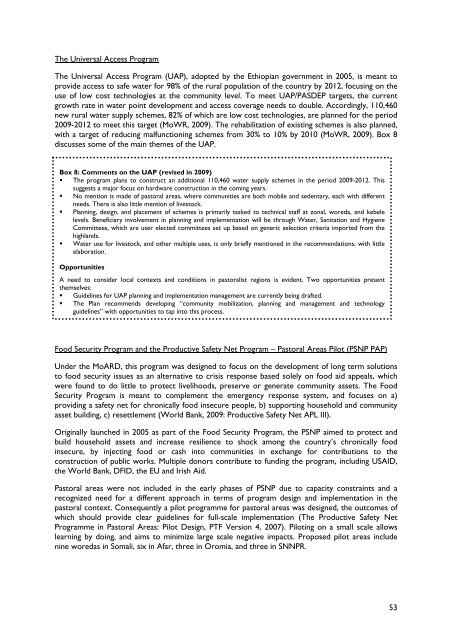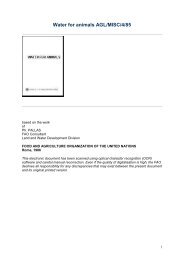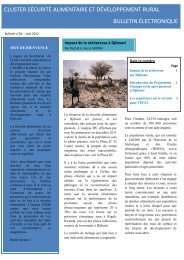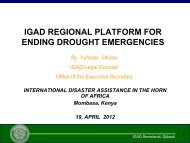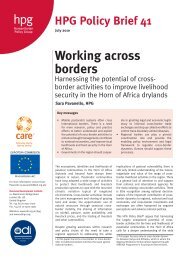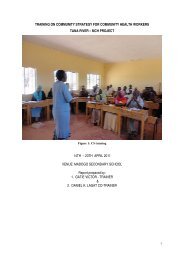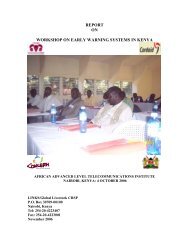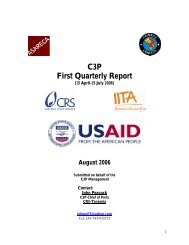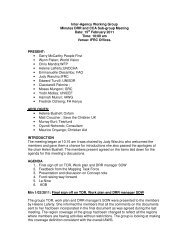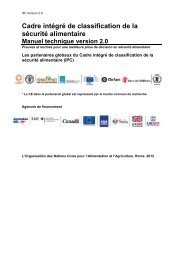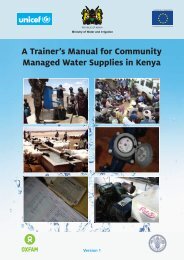<str<strong>on</strong>g>of</str<strong>on</strong>g> total regi<strong>on</strong>al investment target 4 regi<strong>on</strong>s. These 4 regi<strong>on</strong>s include SNNPR <str<strong>on</strong>g>and</str<strong>on</strong>g> Oromia, whichhost pastoral populati<strong>on</strong>s (WSDP 2002).The main implementati<strong>on</strong> strategy outlined calls for capitalizing <str<strong>on</strong>g>and</str<strong>on</strong>g> building <strong>on</strong> existing instituti<strong>on</strong>alstructures, promoting decentralized management involving communities in local water governance,bridging technical capacity gaps, <str<strong>on</strong>g>and</str<strong>on</strong>g> promoting partnerships at all levels. However, for both watersupply <str<strong>on</strong>g>and</str<strong>on</strong>g> irrigati<strong>on</strong>, <strong>the</strong> WSDP recognizes that low community participati<strong>on</strong> in projectidentificati<strong>on</strong>, c<strong>on</strong>structi<strong>on</strong>, operati<strong>on</strong> <str<strong>on</strong>g>and</str<strong>on</strong>g> maintenance is an overarching c<strong>on</strong>straint to <strong>the</strong>implementati<strong>on</strong> <str<strong>on</strong>g>of</str<strong>on</strong>g> <strong>the</strong> program, <str<strong>on</strong>g>and</str<strong>on</strong>g> special emphasis is put <strong>on</strong> <strong>the</strong> establishment <str<strong>on</strong>g>and</str<strong>on</strong>g> involvement <str<strong>on</strong>g>of</str<strong>on</strong>g>Water Users’ Associati<strong>on</strong>s (WUAs). It also recognizes o<strong>the</strong>r major c<strong>on</strong>straints, such as <strong>the</strong> shortage<str<strong>on</strong>g>of</str<strong>on</strong>g> skilled manpower at all administrative levels <str<strong>on</strong>g>and</str<strong>on</strong>g> insufficient capacity to implement.The WSDP also notes <strong>the</strong> potential impacts <str<strong>on</strong>g>of</str<strong>on</strong>g> <strong>the</strong> program <strong>on</strong> communities <str<strong>on</strong>g>and</str<strong>on</strong>g> <strong>the</strong>ir instituti<strong>on</strong>s.Special attenti<strong>on</strong> is to be given to how community instituti<strong>on</strong>s <str<strong>on</strong>g>and</str<strong>on</strong>g> local government interact. It alsorecognizes that program activities could affect <strong>the</strong> livelihoods <str<strong>on</strong>g>of</str<strong>on</strong>g> vulnerable <str<strong>on</strong>g>and</str<strong>on</strong>g> marginalized socialgroups, specifically menti<strong>on</strong>ing pastoralists <str<strong>on</strong>g>and</str<strong>on</strong>g> agro-pastoralists in <strong>the</strong> lowl<str<strong>on</strong>g>and</str<strong>on</strong>g>s, <str<strong>on</strong>g>and</str<strong>on</strong>g> that carefulc<strong>on</strong>siderati<strong>on</strong> is required for <strong>the</strong>se issues in program implementati<strong>on</strong>.The Water Supply, Sanitati<strong>on</strong> <str<strong>on</strong>g>and</str<strong>on</strong>g> Hygiene Program (WSSP)In 2004, <strong>the</strong> MoWR launched <strong>the</strong> Water Supply, Sanitati<strong>on</strong> <str<strong>on</strong>g>and</str<strong>on</strong>g> Hygiene Program (WSSP) whichoutlines plans to c<strong>on</strong>struct about 5,500 community-managed rural water supply schemes. Pastoralcommunities in Afar, Somali, Oromia <str<strong>on</strong>g>and</str<strong>on</strong>g> SNNPR Regi<strong>on</strong>s are major beneficiaries (MoWR, 2009). In2006, it was realized that implementati<strong>on</strong> <str<strong>on</strong>g>of</str<strong>on</strong>g> <strong>the</strong> WSSP in pastoral regi<strong>on</strong>s could not be achievedwithout special c<strong>on</strong>siderati<strong>on</strong> for <strong>the</strong> needs <str<strong>on</strong>g>of</str<strong>on</strong>g> lowl<str<strong>on</strong>g>and</str<strong>on</strong>g> areas. This resulted in <strong>the</strong> development <str<strong>on</strong>g>of</str<strong>on</strong>g>Specific Implementati<strong>on</strong> Guidelines for Pastoralist Areas which take into c<strong>on</strong>siderati<strong>on</strong> “<strong>the</strong>envir<strong>on</strong>mental, social, technological, <str<strong>on</strong>g>and</str<strong>on</strong>g> o<strong>the</strong>r peculiarities <str<strong>on</strong>g>of</str<strong>on</strong>g> pastoral communities.” Box 7discusses <str<strong>on</strong>g>and</str<strong>on</strong>g> highlights some <str<strong>on</strong>g>of</str<strong>on</strong>g> <strong>the</strong> central <strong>the</strong>mes menti<strong>on</strong>ed in <strong>the</strong> guidelines.Box 7: Central <strong>the</strong>mes <str<strong>on</strong>g>and</str<strong>on</strong>g> highlights <str<strong>on</strong>g>of</str<strong>on</strong>g> <strong>the</strong> WSSP for Pastoral Areas (based <strong>on</strong> Giovannetti2006)• Water point selecti<strong>on</strong> <str<strong>on</strong>g>and</str<strong>on</strong>g> placement: The way in which <strong>the</strong> guidelines are presented suggests that waterpoint selecti<strong>on</strong> <str<strong>on</strong>g>and</str<strong>on</strong>g> placement is guided more by technical <str<strong>on</strong>g>and</str<strong>on</strong>g> cost c<strong>on</strong>siderati<strong>on</strong>s ra<strong>the</strong>r than how <strong>the</strong>water point will impact <strong>on</strong> local people/livestock/l<str<strong>on</strong>g>and</str<strong>on</strong>g>scape interacti<strong>on</strong>s.• Mobility: Explicitly recognized in <strong>the</strong> document. The guidelines promote c<strong>on</strong>text specific planning, statingthat “a case-by-case basis <str<strong>on</strong>g>of</str<strong>on</strong>g> <strong>the</strong> actual movements <str<strong>on</strong>g>of</str<strong>on</strong>g> a given community is paramount to approachingproperly its water supply issues.” Also recognizes that sedentarizati<strong>on</strong> threatens <strong>the</strong> balance betweenlivestock, pasture <str<strong>on</strong>g>and</str<strong>on</strong>g> water.• Settlement: The guidelines recognize different settlement patterns in pastoral areas. For Afar <str<strong>on</strong>g>and</str<strong>on</strong>g> Somali, 4different settlement patterns are identified: 1) permanent sedentary settlements without pastoralists, 2)permanent sedentary settlements where pastoralists are present for several m<strong>on</strong>ths with <strong>the</strong>ir livestock,3) permanent sedentary settlements where pastoralists spend a few days to a few weeks with <strong>the</strong>irlivestock, 4) n<strong>on</strong> permanent settlements <str<strong>on</strong>g>of</str<strong>on</strong>g> pastoralists with significant but temporary presence <str<strong>on</strong>g>of</str<strong>on</strong>g>livestock.• Participati<strong>on</strong>: The guidelines recommend that defining who <strong>the</strong> ‘community’ is should be d<strong>on</strong>e <strong>on</strong> a case bycase basis. Participati<strong>on</strong> is envisi<strong>on</strong>ed as expressing dem<str<strong>on</strong>g>and</str<strong>on</strong>g> for water supply, participating physically <str<strong>on</strong>g>and</str<strong>on</strong>g>/orfinancially in c<strong>on</strong>structi<strong>on</strong>, <str<strong>on</strong>g>and</str<strong>on</strong>g> taking care <str<strong>on</strong>g>of</str<strong>on</strong>g> operati<strong>on</strong> <str<strong>on</strong>g>and</str<strong>on</strong>g> maintenance. A user elected CommunityWater, Sanitati<strong>on</strong> <str<strong>on</strong>g>and</str<strong>on</strong>g> Hygiene Committees should represent <strong>the</strong> community in planning <str<strong>on</strong>g>and</str<strong>on</strong>g> management<str<strong>on</strong>g>of</str<strong>on</strong>g> water facilities.• Highl<str<strong>on</strong>g>and</str<strong>on</strong>g> influence: The guidelines recognize that due to low technical capacity in pastoral regi<strong>on</strong>s,pr<str<strong>on</strong>g>of</str<strong>on</strong>g>essi<strong>on</strong>als from highl<str<strong>on</strong>g>and</str<strong>on</strong>g> regi<strong>on</strong>s are usually brought in to fill gaps bringing with <strong>the</strong>m highl<str<strong>on</strong>g>and</str<strong>on</strong>g>approaches which are different to those appropriate in <strong>the</strong> lowl<str<strong>on</strong>g>and</str<strong>on</strong>g>s.• Impact: The document acknowledges that large capacity water points could attract too many livestock fora given area. It recommends that water points not exceed a size that waters a maximum <str<strong>on</strong>g>of</str<strong>on</strong>g> 4,500 head <str<strong>on</strong>g>of</str<strong>on</strong>g>cattle a day <str<strong>on</strong>g>and</str<strong>on</strong>g> that <strong>the</strong>y are spaced about 20km apart to avoid overgrazing.• Community C<strong>on</strong>tributi<strong>on</strong>: The guidelines recommend that <strong>the</strong> community should c<strong>on</strong>tribute 5% in cash <str<strong>on</strong>g>and</str<strong>on</strong>g>5% in kind to c<strong>on</strong>structi<strong>on</strong>. However, it also menti<strong>on</strong>s that requiring a cash c<strong>on</strong>tributi<strong>on</strong> could excludemost communities from <strong>the</strong> benefit <str<strong>on</strong>g>of</str<strong>on</strong>g> <strong>the</strong> WSSP.52
The Universal Access ProgramThe Universal Access Program (UAP), adopted by <strong>the</strong> Ethiopian government in 2005, is meant toprovide access to safe water for 98% <str<strong>on</strong>g>of</str<strong>on</strong>g> <strong>the</strong> rural populati<strong>on</strong> <str<strong>on</strong>g>of</str<strong>on</strong>g> <strong>the</strong> country by 2012, focusing <strong>on</strong> <strong>the</strong>use <str<strong>on</strong>g>of</str<strong>on</strong>g> low cost technologies at <strong>the</strong> community level. To meet UAP/PASDEP targets, <strong>the</strong> currentgrowth rate in water point development <str<strong>on</strong>g>and</str<strong>on</strong>g> access coverage needs to double. Accordingly, 110,460new rural water supply schemes, 82% <str<strong>on</strong>g>of</str<strong>on</strong>g> which are low cost technologies, are planned for <strong>the</strong> period2009-2012 to meet this target (MoWR, 2009). The rehabilitati<strong>on</strong> <str<strong>on</strong>g>of</str<strong>on</strong>g> existing schemes is also planned,with a target <str<strong>on</strong>g>of</str<strong>on</strong>g> reducing malfuncti<strong>on</strong>ing schemes from 30% to 10% by 2010 (MoWR, 2009). Box 8discusses some <str<strong>on</strong>g>of</str<strong>on</strong>g> <strong>the</strong> main <strong>the</strong>mes <str<strong>on</strong>g>of</str<strong>on</strong>g> <strong>the</strong> UAP.Box 8: Comments <strong>on</strong> <strong>the</strong> UAP (revised in 2009)• The program plans to c<strong>on</strong>struct an additi<strong>on</strong>al 110,460 water supply schemes in <strong>the</strong> period 2009-2012. Thissuggests a major focus <strong>on</strong> hardware c<strong>on</strong>structi<strong>on</strong> in <strong>the</strong> coming years.• No menti<strong>on</strong> is made <str<strong>on</strong>g>of</str<strong>on</strong>g> pastoral areas, where communities are both mobile <str<strong>on</strong>g>and</str<strong>on</strong>g> sedentary, each with differentneeds. There is also little menti<strong>on</strong> <str<strong>on</strong>g>of</str<strong>on</strong>g> livestock.• Planning, design, <str<strong>on</strong>g>and</str<strong>on</strong>g> placement <str<strong>on</strong>g>of</str<strong>on</strong>g> schemes is primarily tasked to technical staff at z<strong>on</strong>al, woreda, <str<strong>on</strong>g>and</str<strong>on</strong>g> kebelelevels. Beneficiary involvement in planning <str<strong>on</strong>g>and</str<strong>on</strong>g> implementati<strong>on</strong> will be through Water, Sanitati<strong>on</strong> <str<strong>on</strong>g>and</str<strong>on</strong>g> HygieneCommittees, which are user elected committees set up based <strong>on</strong> generic selecti<strong>on</strong> criteria imported from <strong>the</strong>highl<str<strong>on</strong>g>and</str<strong>on</strong>g>s.• Water use for livestock, <str<strong>on</strong>g>and</str<strong>on</strong>g> o<strong>the</strong>r multiple uses, is <strong>on</strong>ly briefly menti<strong>on</strong>ed in <strong>the</strong> recommendati<strong>on</strong>s, with littleelaborati<strong>on</strong>.OpportunitiesA need to c<strong>on</strong>sider local c<strong>on</strong>texts <str<strong>on</strong>g>and</str<strong>on</strong>g> c<strong>on</strong>diti<strong>on</strong>s in pastoralist regi<strong>on</strong>s is evident. Two opportunities present<strong>the</strong>mselves:• Guidelines for UAP planning <str<strong>on</strong>g>and</str<strong>on</strong>g> implementati<strong>on</strong> management are currently being drafted.• The Plan recommends developing “community mobilizati<strong>on</strong>, planning <str<strong>on</strong>g>and</str<strong>on</strong>g> management <str<strong>on</strong>g>and</str<strong>on</strong>g> technologyguidelines” with opportunities to tap into this process.Food Security Program <str<strong>on</strong>g>and</str<strong>on</strong>g> <strong>the</strong> Productive Safety Net Program – Pastoral Areas Pilot (PSNP PAP)Under <strong>the</strong> MoARD, this program was designed to focus <strong>on</strong> <strong>the</strong> development <str<strong>on</strong>g>of</str<strong>on</strong>g> l<strong>on</strong>g term soluti<strong>on</strong>sto food security issues as an alternative to crisis resp<strong>on</strong>se based solely <strong>on</strong> food aid appeals, whichwere found to do little to protect livelihoods, preserve or generate community assets. The FoodSecurity Program is meant to complement <strong>the</strong> emergency resp<strong>on</strong>se system, <str<strong>on</strong>g>and</str<strong>on</strong>g> focuses <strong>on</strong> a)providing a safety net for chr<strong>on</strong>ically food insecure people, b) supporting household <str<strong>on</strong>g>and</str<strong>on</strong>g> communityasset building, c) resettlement (World Bank, 2009: Productive Safety Net APL III).Originally launched in 2005 as part <str<strong>on</strong>g>of</str<strong>on</strong>g> <strong>the</strong> Food Security Program, <strong>the</strong> PSNP aimed to protect <str<strong>on</strong>g>and</str<strong>on</strong>g>build household assets <str<strong>on</strong>g>and</str<strong>on</strong>g> increase resilience to shock am<strong>on</strong>g <strong>the</strong> country’s chr<strong>on</strong>ically foodinsecure, by injecting food or cash into communities in exchange for c<strong>on</strong>tributi<strong>on</strong>s to <strong>the</strong>c<strong>on</strong>structi<strong>on</strong> <str<strong>on</strong>g>of</str<strong>on</strong>g> public works. Multiple d<strong>on</strong>ors c<strong>on</strong>tribute to funding <strong>the</strong> program, including USAID,<strong>the</strong> World Bank, DFID, <strong>the</strong> EU <str<strong>on</strong>g>and</str<strong>on</strong>g> Irish Aid.Pastoral areas were not included in <strong>the</strong> early phases <str<strong>on</strong>g>of</str<strong>on</strong>g> PSNP due to capacity c<strong>on</strong>straints <str<strong>on</strong>g>and</str<strong>on</strong>g> arecognized need for a different approach in terms <str<strong>on</strong>g>of</str<strong>on</strong>g> program design <str<strong>on</strong>g>and</str<strong>on</strong>g> implementati<strong>on</strong> in <strong>the</strong>pastoral c<strong>on</strong>text. C<strong>on</strong>sequently a pilot programme for pastoral areas was designed, <strong>the</strong> outcomes <str<strong>on</strong>g>of</str<strong>on</strong>g>which should provide clear guidelines for full-scale implementati<strong>on</strong> (The Productive Safety NetProgramme in Pastoral Areas: Pilot Design, PTF Versi<strong>on</strong> 4, 2007). Piloting <strong>on</strong> a small scale allowslearning by doing, <str<strong>on</strong>g>and</str<strong>on</strong>g> aims to minimize large scale negative impacts. Proposed pilot areas includenine woredas in Somali, six in Afar, three in Oromia, <str<strong>on</strong>g>and</str<strong>on</strong>g> three in SNNPR.53
- Page 1 and 2: Synthesis
- Page 4 and 5: TABLE OF CONTENTSLIST OF ACRONYMS..
- Page 6 and 7: ACKNOWLEDGMENTSI would like to exte
- Page 8 and 9: LIST OF ACRONYMSACDI/VOCAACFAFDCDDC
- Page 10 and 11: EXECUTIVE SUMMARYWater development
- Page 12 and 13: understanding <str
- Page 14 and 15: Agreed upon guidelines for water de
- Page 16 and 17: • Make better use of</str
- Page 18 and 19: to inform their own work an
- Page 20 and 21: Within pastoral areas, it is recogn
- Page 23 and 24: Section 2. Overview of</str
- Page 25 and 26: Dohrn, 2006). Spatially variable ra
- Page 27 and 28: The following broad overview touche
- Page 29 and 30: In areas of adequa
- Page 31 and 32: observed response was for individua
- Page 33 and 34: Specific to water development, seve
- Page 35 and 36: Section 3. Water development todayT
- Page 37 and 38: Eliciting payments for water from l
- Page 39 and 40: ureaus 25 . The ministry’s interv
- Page 41 and 42: National policy paints a conflictin
- Page 43 and 44: will be given to pastoralists to en
- Page 45 and 46: Water supplyGovernance and<
- Page 47 and 48: vulnerable to conversion for other
- Page 49 and 50: • Agro-pastoralists’ priorities
- Page 51: Although the WSDP principles are se
- Page 55 and 56: • Help ensure that public works d
- Page 57 and 58: However, the development model for
- Page 59 and 60: Figure 4: Proposed pilot la
- Page 61 and 62: Many international and</str
- Page 63 and 64: Furthermore, attention is given to
- Page 65 and 66: CARE International, under the GWI,
- Page 67: and traditional me
- Page 70 and 71: • Understand exi
- Page 72 and 73: 4.2 Key observations in the water d
- Page 74 and 75: epresent a firm attempt to preserve
- Page 76 and 77: learning from NGO experiences in Bo
- Page 78 and 79: However, there are currently no spe
- Page 80 and 81: 4.3 Conclusion, ways forward <stron
- Page 82 and 83: In sum, pastoralism as a livelihood
- Page 84 and 85: • Water interventions selected sh
- Page 86 and 87: • Promote effective participation
- Page 88 and 89: Gebre-Mariam, A. (1982). Organizati
- Page 90: Schimann P. and Ph


